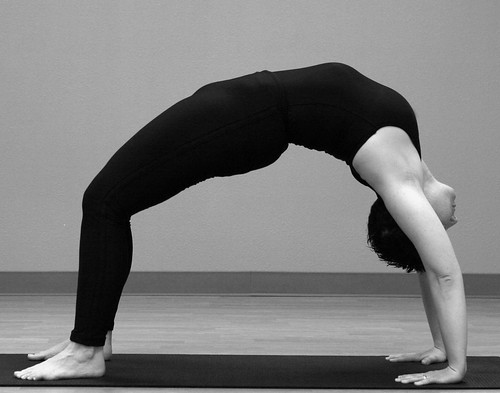A good back-bend has the perfect balance between flattening the thoracic spine (mid & upper back) and increasing the arch in the lumbar spine (lower back). The lower back is designed to arch - that is what it does already! The upper back, one the other hand, is designed to round forward slightly. The shape of these curves and whether they are healthy depends on our genes and also our movement habits, all of which influence our ability to bend backwards. And yes, too much slumping in front of a computer makes for uncomfortable back-bends!
All the girls in the pictures below are very comfortable in urdvha dhanurasana (upward bow pose), but all their back-bends look different. The factors I have already talked about play a large part, but so do their bones (yes, it's another bone post!)

The spinous processes are those bits of bone sticking out of each vertebra where the muscles and ligaments attach. If they are longer, you will not be able to bend as far back before they crunch together as someone with shorter spinous processes. Also, the relative length of the spinous processes differs along the spine and from person to person.Have a look at the pics and see the differences for yourself!
Andrea in Urdhva Dhanurasana, originally uploaded by LORatliff.
Julie in Urdhva Dhanurasana, originally uploaded by LORatliff.
Note: Thanks to Debbie and Karen for the photos, wikipedia for the anatomy pic, and to the lovely folks who share their pics on flickr!






8 comments:
A very interesting post! I find this back bend near impossible for me but maybe it's because I have never had anyone really help me through all the basics of it. I also think my shoulders really get in the way of my getting up into this posture... I don't know, maybe it has to do with strength as well, but I am pretty good with my upper body strength. I think it's just the mechanics of getting there...
Maybe someday I can post my picture here!
Excellent post, Nadine!
Hi Regina Clare Jane!
I think this is one of those poses that a teacher is useful for - there really is so much going on, and once you are strong & flexible enough, it's about overcoming the fear and getting the knack. Good luck, can't wait to post your picture.
the shoulders are a very important aspect of this pose. I was only able to get up into this pose when I STOPPED listening to teachers' recommendations of where my hands "should" be in this pose, and started intuiting where my hands should be FOR MY BODY. As soon as I let go from the way it "should be" according to others' interpretations of alignment for other peoples' bodies, that's when I easily lifted off the ground.
yoga is all in the bones.
Hi Linda!
Thank you for the lovely insight. Maybe this will help Regina Clare Jane, too.
Funny, I just spent my day at a 3 hour back bends workshop with Mitchel Bleier with a focus on Urdhva D. and came home and am now reading this post. I have to say that intense back bends are big stuff for me. If I practice them improperly, I suffer pain for days afterwards, and they tend to cough up emotional stuff, and I can't sleep for a long time afterwards either. So it was great to get some expert input.
Bleier shared a number of cool ideas. I'll share just a few. 1. take the inner thigh back, pulling the sacrum up, lowering the pelvis forward to create a safe form to build the back bend around. To get the hang of it, we did Setu Bandha Sarvangasana with a block between our legs and tried to pass it to the floor by rotating the thighs. We also did this with our toes and knees pushing into a wall and our heart expanding away. 2. in Urdhva D., keep the shoulders together and heart expanding outward. 3. coming into the pose from standing (can be done with a partner) it is easier to find the proper form for the final pose than it is to come at it from the ground.
Lots of concentration and body awareness for these poses, they aren't for the faint of heart.
Oh, thanks to Linda and kb for the really interesting comments! I especially found the coming down into a backbend rather than coming up into one as suggested by kb very helpful!
Thanks Linda and KB - very interesting stuff. KB, I used to get all the same reactions as you in back-bends, and I believe that sometimes, if we are not strong enough to hold the space for what they bring up (emotionally or physically) we need to step back and focus on building that strength first. Thanks for reminding me: full post on the topic coming shortly.
you can also come into this pose by standing near a wall (back turned to wall, distance from wall determined by the length of your torso and arms!) and leaning back and walking your hands down the wall. hard to explain without seeing it!
Post a Comment